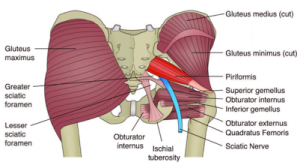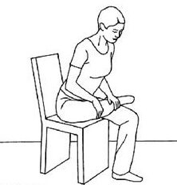ADVICE
Pain in the Bum and the Piriformis
Do you get pain in the buttocks and hips when sitting? Do your hips feel stiff and immobile? You might even experience a sensation of tingling, weakness or numbness radiating into the lower back, down the hamstrings and into the calves. These symptoms could be explained by a very common and resolvable muscular issue – a tight piriformis.
If you’ve never heard of the piriformis, it’s a muscle that lies deep in the buttocks, attaching from the sacrum to the top of the femur. Its primary function is to assist the gluteus maximus outwardly rotate the hip. A visible sign of a tight piriformis is if one of your feet drops out to the side more than the when you’re lying on your back. A tight piriformis can contribute to other lower limb problems like knee and heel pain (plantar fasciitis) and in more extreme cases it compresses the sciatic nerve giving the symptoms of sciatica.
So, how does the piriformis become tight?
If, like so many us, you spend most of our waking hours sitting at a desk, or in a car, or watching TV, there is a reasonable chance that your hip flexors are tight which can contribute to the gluteus maximus muscles not functioning optimally. One of the primary functions of the gluteus maximus is to outwardly rotate the hip and the piriformis assists with this action. However, if the glute max isn’t functioning fully, the piriformis overworks to compensate for the relative weakness of the glute max. This can lead to it being overworked and tight.
So, to address the problem we need to do three things: Stretch the piriformis and the hip flexors and strengthen the glutes.
Stretching the piriformis can help to restore its optimal length, providing immediate relief. There are numerous effective stretches.
- Sit up straight in a normal kitchen chair with your feet flat on the ground and knees at approximately 90 degrees. Pull one leg up, resting your ankle on the opposite knee and making sure the top leg is parallel to the floor. Keeping your back straight, slowly bring your chest forward until you feel your hips begin to stretch. Stay in that position for 20 to 30 seconds then slowly raise your body back up. Repeat 2 or 3 times and move on to the opposite leg.
A second, more intense stretch can be achieved by lying flat on your back. Bring your right knee into your chest and use your right hand to push the right knee towards the left shoulder. To further increase the stretch, take the right heel in the left hand and pull the right foot towards the left shoulder. You should feel an intense stretch in the right buttock. Hold for 30 seconds and repeat 3 times. Repeat for left side.
There are several Yoga poses that also provide a great stretch to the piriformis muscles. Click on the links below for detailed descriptions on how to achieve them.
Cowface Pose
https://www.yogajournal.com/poses/cow-face-pose
Pigeon Pose
https://www.ekhartyoga.com/more-yoga/yoga-poses/pigeon-pose
Deep tissue massage and soft tissue release techniques can also help to release a piriformis in spasm.
Stretching alone may provide relief but it won’t prevent the problem recurring in the long term; glute strengthening must be part of the treatment.
Finding time to stretch the piriformis and strengthen the glutes will improve the delicate muscular balance of the hips, leaving you feeling more supple and stronger with fewer aches and pains.


